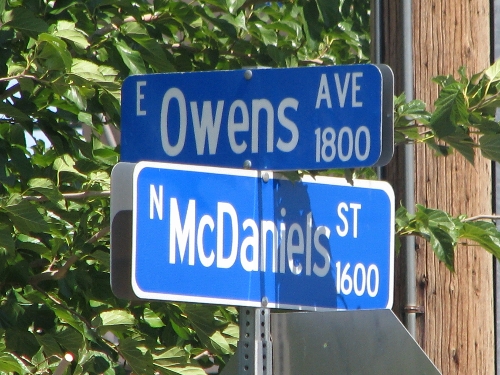History unclear: Las Vegas’ Owens Avenue has two possible namesakes

Although the Las Vegas Valley is relatively young, some history already has been lost. Such is the case with Owens Avenue.
“Asphalt Memories,” by Mark Hall-Patton, director of Clark County Museums, lists two possibilities as the street’s namesake. A proposal to change the name of the road was put before the Clark County Commission in 1980. Although the name change was eventually defeated, it brought the two competing namesake theories into public record.
Robert Williams Owens, a Searchlight native, had a ranch near what would become Owens Avenue. He served as undersheriff of Clark County under Sheriff Glen Jones. Jones served from 1943-55 when he resigned after being caught on tape taking bribes. Before that, Jones was in hot water for allegedly bugging the district attorney’s office.
Mosten T. “Moses” Owens seems a more likely namesake candidate, both to Hall-Patton and fellow historian Michael Green, a professor at the College of Southern Nevada.
“Moses was there much earlier,” Green said. “He’s so tied up with (North Las Vegas founder) Tom Williams and the history of the place that it would be strange if it wasn’t named for him.”
Owens was one of the earliest settlers in Old Town, which later became North Las Vegas. A 1976 brochure titled “The Adobe on the Kyle Ranch Built in the 1870s” lists several facts about him.
Dennis McBride, curator of history and collections at the Nevada State Museum, points out that even the title of the brochure has a misstatement.
“That was everyone’s best guess at the time, but we’ve since found that the adobe structure isn’t that old,” he said. “We have photos showing that it was built after the house, in the early 20th century.”
The brochure states that Owens was well established in the area by the late 1920s, living on property he called Amargosa Rose Ranch, near the Kyle Ranch. He grew nothing but roses, and his property was a blast of color in a mostly brown landscape. That wasn’t the only colorful thing about the ranch or the character who lived there.
The brochure states that “Mosten lived in a small shack. It was, like Owens himself, somewhat disheveled.”
It also notes that he was dedicated to strong brew and “frequently lacked proper, or indeed any, attire.”
As fascinating reading as the pamphlet is, some of the information should probably be taken with a grain of salt. For instance, it quotes Bill Craig, who moved to the Kyle Ranch at the age of 10 in 1926 and recalled, “Mosten was the blacksheep (sic) of a wealthy English family. They sent him a monthly stipend to make sure that he stayed away from England.”
The early history of North Las Vegas involves a lot of bootlegging and booze, and tall tales and misinformation are usually associated with both.
“It’s possible that it’s true,” said Hall-Patton. “But it’s more likely he was the third son or something and he had no inheritance, or that it was just a story.”
Several sources mention the roses, which were renowned throughout Southern Nevada and refer to Owens as an eccentric, so those two facts seem reasonably certain.
Although it’s unclear whom the road honors, the general consensus is that it’s either the right-hand man to one of the valley’s most corrupt lawmen or a drunken eccentric who lived in a tiny shack surrounded by thorny roses and may have spent a fair amount of time naked.
Contact Sunrise and Whitney View reporter F. Andrew Taylor at ataylor@viewnews.com or 380-4532.